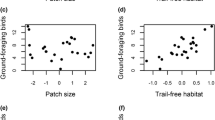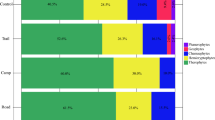Abstract
Ground-layer vegetation was sampled along selected trail corridors to determine whether corridors provide habitat for certain species and act as conduits for species movement. Patterns of plant species composition were analyzed in relation to distance from trail edge, level of trail use, and distance from trailheads, junctions, and campgrounds. Species composition was significantly affected by distance from trail edge and level of trail use, as species were favored or inhibited by the corridor, depending upon their growth habits. Species composition was also affected by distance from trailheads. These findings, along with the presence of exotic species, indicate that trail corridors in Rocky Mountain National Park function as habitat and conduits for movement of plant species.
Similar content being viewed by others
References
Bates, G.H. 1935. The vegetation of footpaths, sidewalks, cart-tracks and gateways. J. Ecol. 23: 463–487.
Baudry, J. 1984. Effects of landscape structure on biological communities: The case of hedgerow network landscapes. In Proceedings of the first international seminar of the International Association of Landscape Ecology. Vol. 1, pp. 55–65. Edited by J. Brandt and P. Agger. Roskilde University Centre, Roskilde, Denmark.
Bayfield, N.G. 1973. Use and deterioration of some Scottish hill paths. J. Appl. Ecol. 10: 635–644.
Benninger, M.C. 1989. Trails as conduits of movement for plant species in coniferous forests of Rocky Mountain National Park, Colorado. Masters thesis, Miami University, Oxford, Ohio.
Bright, J.A. 1986. Hiker impact on herbaceous vegetation along trails in an evergreen woodland of central Texas. Biol. Conserv. 36: 53–59.
Burden, R.F. and Randerson, P.F. 1972. Quantitative studies of the effects of human trampling on vegetation as an aid to the management of semi-natural areas. J. Appl. Ecol. 9: 439–457.
Chappell, H.G., Ainsworth, J.F., Cameron, R.A.D. and Redfern, M. 1971. The effect of trampling on a chalk grassland ecosystem. J. Appl. Ecol. 8: 869–882.
Clements, F.E. 1928. Plant succession and indicators. H.W. Wilson Company, New York.
Cole, D.N. 1978. Estimating the susceptibility of wildland vegetation to trailside alteration. J. Appl. Ecol. 15: 281–286.
Cole, D.N. 1981. Vegetational changes associated with recreational use and fire suppression in the Eagle Cap Wilderness, Oregon: Some management implications. Biol. Conserv. 20: 247–270.
Dale, D. and Weaver, T. 1974. Trampling effects on vegetation of the trail corridors of north Rocky Mountain forests. J. Appl. Ecol. 11: 767–772.
Forman, R.T.T. 1981. Interactions among landscape elements: A core of landscape ecology. In Proceedings of the International Congress organized by the Netherlands Society for Landscape Ecology, Veldhoven, The Netherlands. pp. 35–48. Edited by S.P. Tjallingii and A.A. de Veer. Centre for Agricultural Publishing and Documentation, Wageningen.
Forman, R.T.T. 1984. Landscape ecology principles and landscape function. In Proceedings of the first international seminar of the International Association of Landscape Ecology. Vol. 5, pp. 4–5. Edited by J. Brandt and P. Agger. Roskilde University Centre, Roskilde, Denmark.
Forman, R.T.T. and Godron, M. 1981. Patches and structural components for a landscape ecology. Bioscience 31: 733–740.
Forman, R.T.T. and Godron, M. 1986. Landscape ecology. John Wiley & Sons, New York.
Getz, L.L., Cole, F.R. and Gates, D.L. 1978. Interstate roadsides as dispersal routes for Microtus pensylvanicus. J. Mammal. 59: 208–212.
Grime, J.P. 1973. Control of species density in herbaceous vegetation. J. Env. Manag. 1: 151–167.
Hall, C.N. and Kuss, F.R. 1989. Vegetation alteration along trails in Shenandoah National Park, Virginia. Biol. Conserv. 48: 211–227.
Hammitt, W.E. and Cole, D.N, 1987. Wildland recreation. John Wiley & Sons, New York.
Harrington, H.D. 1964. Manual of the plants of Colorado. Swallow Press, Chicago.
Harris, L.D. and Gallagher, P.B. 1989. New initiatives for wildlife conservation: The need for movement corridors. In defense of wildlife: Preserving communities and corridors. pp. 11–34. Edited by G. Mackintosh. Defenders of Wildlife, Washington, DC.
Kuss, F.R. and Graefe, A.R. 1985. Effects of recreation trampling on natural area vegetation. J. Leisure Research 17: 165–183.
Liddle, M.J. 1975. A selective review of the ecological effects of human trampling on natural ecosystems. Biol. Conserv. 7: 17–36.
Liddle, M.J. and Greig-Smith, P. 1975. A survey of tracks and paths in a sand dune ecosystem. J. Appl. Ecol. 12: 909–930.
Nelson, R.A. 1982. Plants of Rocky Mountain National Park. Fifth edition, Rocky Mountain Nature Association, Boulder, Colorado.
Nip-van der Voort, J., Hengefeld, R. and Haeck, J. 1979. Immigration rates of plant species in three Dutch polders. J. Biogeogr. 6: 301–308.
Peet, R.K. 1981. Forest vegetation of the Colorado Front Range. Vegetatio 45: 3–75.
Peet, R.K. 1988. Forests of the Rocky Mountains. In North American terrestrial vegetation. pp. 63–101. Edited by M.G. Barbour and W.D. Billings. Cambridge University Press, Cambridge, England.
Rocky Mountain National Park Trail Plan. 1982. Denver Service Center, National Park Service, U.S. Department of the Interior.
Vankat, J.L. 1990. A classification of the forest types of North America. Vegetatio 88: 53–66.
Verkaar, H.J. 1988. The possible role of road verge and river dykes as corridors for the exchange of plant species between natural habitats. In Proceedings of the 2nd international seminar of the International Association for Landscape Ecology. pp. 79–84. Edited by Karl-Friedrich Schreiber. Schöningh, Paderborn.
Weber, W.A. 1976. Rocky mountain flora. Fifth edition, Colorado Associated University Press, Boulder, Colorado.
Wegner, J.F. and Merriam, H.G. 1979. Movements by birds and small mammals between a wood and adjoining farmland habitats. J. Appl. Ecol. 16: 349–358.
Westhoff, V. 1967. The ecological impact of pedestrian, equestrian and vehicular traffic on vegetation. Proceedings and Papers of the Tenth Technical Meeting of I.U.C.N. 10: 218–223.
Author information
Authors and Affiliations
Rights and permissions
About this article
Cite this article
Benninger-Truax, M., Vankat, J.L. & Schaefer, R.L. Trail corridors as habitat and conduits for movement of plant species in Rocky Mountain National Park, Colorado, USA. Landscape Ecol 6, 269–278 (1992). https://doi.org/10.1007/BF00129705
Issue Date:
DOI: https://doi.org/10.1007/BF00129705




